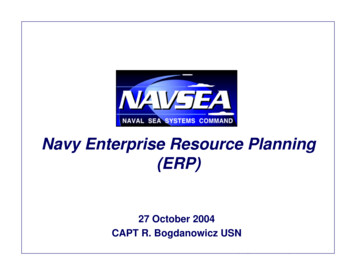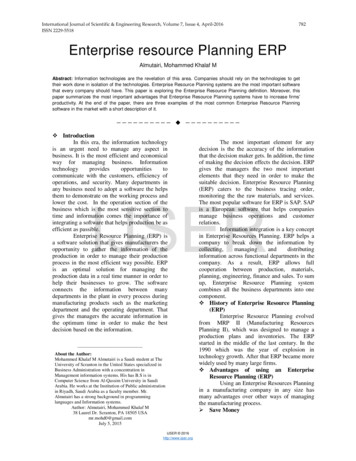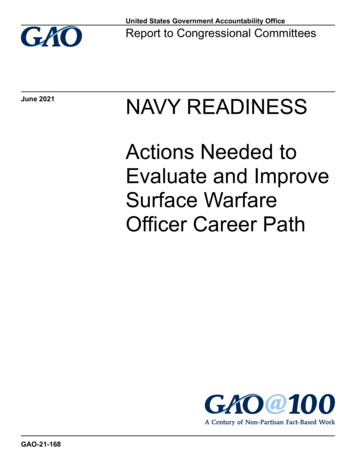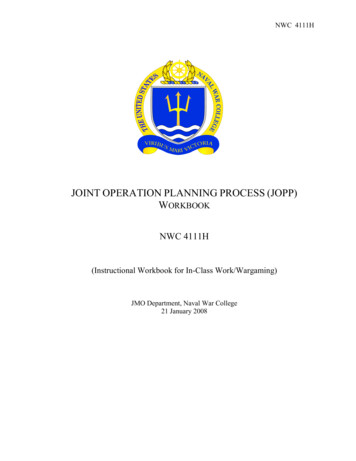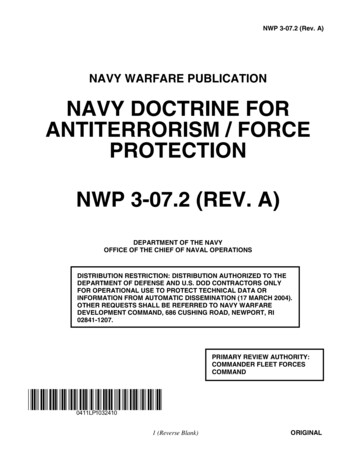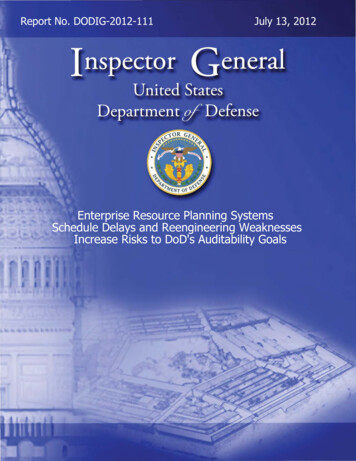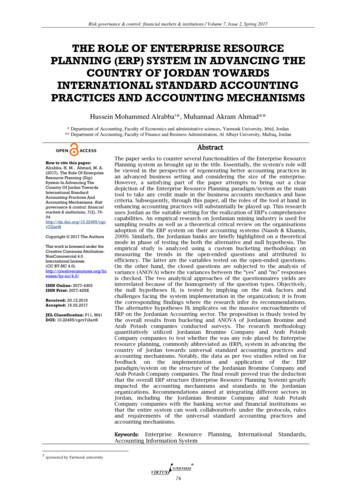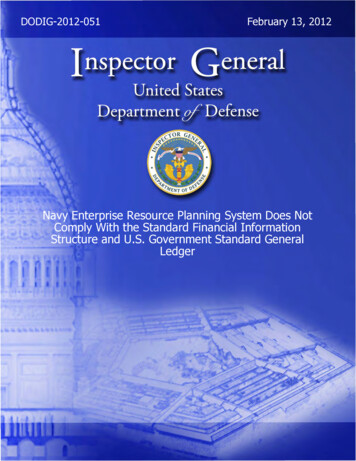
Transcription
DODIG-2012-051February 13, 2012Navy Enterprise Resource Planning System Does NotComply With the Standard Financial InformationStructure and U.S. Government Standard GeneralLedger
Additional CopiesTo obtain additional copies of this report, visit the Web site of the Department of DefenseInspector General at http://www.dodig.mil/audit/reports or contact the Secondary ReportsDistribution Unit at (703) 604-8937 (DSN 664-8937) or fax (571) 372-7469.Suggestions for AuditsTo suggest or request audits, contact the Office of the Deputy Inspector General forAuditing by phone (703) 604-9142 (DSN 664-9142), by fax (571) 372-7469, or by mail:Department of Defense Office of Inspector GeneralOffice of the Deputy Inspector General for AuditingATTN: Audit Suggestions/13F25-044800 Mark Center DriveAlexandria, VA 22350-1500Acronyms and ss Enterprise ArchitectureBusiness Transformation AgencyChart of AccountsDeputy Assistant Secretary of the Navyfor Financial OperationsDeputy Chief Management OfficerDefense Departmental Reporting SystemDefense Finance and Accounting ServiceEnterprise Resource PlanningFederal Financial Management Improvement Act of 1996Office of Financial OperationsInvestment Review BoardNaval Air Systems CommandOffice of Management and BudgetStandard Financial Information StructureUnder Secretary of Defense for Acquisition, Technology,and LogisticsUnder Secretary of Defense (Comptroller)/ChiefInformation Officer, DoDU.S. Government Standard General Ledger
February 13, 2012MEMORANDUM FOR UNDER SECRETARY OF DEFENSE FOR ACQUISITION,TECHNOLOGY, AND LOGISTICSUNDER SECRETARY OF DEFENSE (COMPTROLLER)/CHIEF FINANCIAL OFFICER, DODCHAIRMAN, DEFENSE BUSINESS SYSTEMS MANAGEMENTCOMMITTEEDIRECTOR, DEFENSE FINANCE AND ACCOUNTING SERVICENAVAL INSPECTOR GENERALSUBJECT: Navy Enterprise Resource Planning System Does Not Comply With theStandard Financial Information Structure and U.S. Government Standard GeneralLedger (Report No. DODIG-2012-051)We are providing this report for your review and comment. The Navy approved deployment ofthe Navy Enterprise Resource Planning (ERP) System without ensuring it complied with theStandard Financial Information Structure and the U.S. Government Standard General Ledger.As a result, the Navy spent 870 million to develop and implement a system that might notproduce accurate and reliable financial information. When deployment is complete, the Systemwill manage 54 percent of the Navy’s total obligation authority, which was valued at about 85 billion for FY 2011. We considered management comments on a draft of this report whenpreparing the final report.DoD Directive 7650.3 requires that all recommendations be resolved promptly. The Director,Acquisition Resources and Analysis, comments were not responsive. We request that theDirector, Acquisition Resources and Analysis, provide additional comments on revisedRecommendation 1 by March 13, 2012. The Deputy Chief Management Officer responded forthe Chairman, Defense Business Systems Management Committee. The comments werepartially responsive, and we request additional comments on revised Recommendation 2.a byMarch 13, 2012.Comments from the Deputy Assistant Secretary of the Navy (Financial Management andComptroller, Office of Financial Operations) and the Navy ERP Program Manager, whoresponded for the Assistant Secretary of the Navy (Research, Development, and Acquisition)were partially responsive. We request the Deputy Assistant Secretary and Program Manager,provide additional comments on Recommendations 3.a, 3.b, 3.c, and 3.g by March 13, 2012.Please see the Recommendations Table on page ii of this report.If possible, send a portable document (.pdf) file containing your comments toaudclev@dodig.mil. Copies of the management comments must contain the actual signature ofthe authorizing official. We are unable to accept the /Signed/ symbol in place of the actualsignature. If you arrange to send classified comments electronically, you must send them overthe SECRET Internet Protocol Router Network (SIPRNET).We appreciate the courtesies extended to the staff. Please direct questions to me at(703) 604-8905.Amy J. Frontz, CPAPrincipal Assistant Inspector Generalfor Auditing
Report No. DODIG-2012-051 (Project No. D2011-D000FN-0002.000)February 13, 2012Results in Brief: Navy Enterprise ResourcePlanning System Does Not Comply With theStandard Financial Information Structure andU.S. Government Standard General LedgerThe Defense Business Systems ManagementCommittee Chairman should track the configuration and implementationof BEA requirements to ensure adequateprogress is being made toward the plannedSFIS compliancy date, and require the Investment Review Board toupdate guidance for assessing SFIScompliance to include an independentvalidation before making a systemcertification recommendation.What We DidWe determined whether the Navy EnterpriseResource Planning System (System) compliedwith the Standard Financial InformationStructure (SFIS) and the U.S. GovernmentStandard General Ledger (USSGL).What We FoundThe Navy developed and approved deploymentof the System to 54 percent of its obligationauthority, which was valued at 85 billion forFY 2011, without ensuring that the Systemcomplied with SFIS and USSGL.The Assistant Secretaries of the Navy(Research, Development, and Acquisition andFinancial Management and Comptroller) should implement SFIS requirements for the System,and use the independent SFIS validation toimprove the validation process, update the System Chart of Accounts toinclude all USSGL/DoD accounts used toprepare Navy financial statements, comply with Treasury updates, and review financial operations and policygoverning the System.The Navy did not have an adequate plan toincorporate SFIS requirements into thedevelopment and implementation of the System,did not develop an adequate validation processto assess compliance with SFIS requirements,implemented the System to accommodateexisting Navy Chart of Accounts andnoncompliant procedures, and failed toimplement processes necessary to supportrequirements. As a result, the Navy spent 870 million to develop and implement asystem that might not produce accurate andreliable financial information.Management Comments andOur ResponseThe USD(AT&L) comments werenonresponsive, and we request additionalcomments on Recommendation 1. The DeputyChief Management Officer and Navy commentswere partially responsive, and we requestadditional comments on Recommendations 2.a3.a, 3.b, 3.c, and 3.g. Please see therecommendations table on the back of this page.What We RecommendThe Under Secretary of Defense forAcquisition, Technology, and Logistics(USD[AT&L]) should review the Navy ERPSystem’s Business Enterprise Architecture(BEA) compliance status to ensure adequateprogress is being made toward the plannedFY 2015 SFIS compliance date beforeapproving deployment to additional commands.i
Report No. DODIG-2012-051 (Project No. D2011-D000FN-0002.000)February 13, 2012Recommendations TableManagementRecommendationsRequiring CommentNo Additional CommentsRequiredUnder Secretary of Defense forAcquisition, Technology, andLogistics1Chairman, Defense BusinessSystems ManagementCommittee2.a2.bAssistant Secretary of the Navy(Research, Development, andAcquisition)Assistant Secretary of the Navy(Financial Management andComptroller)3.a, 3.b, 3.c, 3.g3.d, 3.e, 3.f3.a, 3.b, 3.c, 3.g3.d, 3.e, 3.fPlease provide comments by March 13, 2012.ii
Table of ContentsIntroductionAudit ObjectivesBackground on the Navy ERP SystemNavy Needs to Improve Processes for Implementing the ERP SystemFinding. The Navy ERP System Must Comply With SFIS and USSGLStandard Financial Information StructureNavy Officials Need to Address SFIS ComplianceInaccurate SFIS Compliance Self-AssessmentChart of Accounts GuidanceSystem Needs to Include All Reported USSGL/DoD AccountsNavy Officials Should Update the Chart of Accounts as Requiredby Treasury PolicyOfficial Crosswalk Needs to Be Maintained in the SystemFinancial System of Record Must Support Financial StatementsManagement Comments on the Finding and Our ResponseRevised RecommendationsRecommendations, Management Comments, and Our Response11145568910101111131314AppendicesA. Scope and MethodologyUse of Computer-Processed DataUse of Technical AssistancePrior Coverage of the Navy ERP SystemB. Issues Incorrectly Classified as Compliant, Which AffectedFinancial DataC. Navy-Reported Accounts Not Included in the Navy ERP System212222222325Management CommentsUnder Secretary of Defense for Acquisition, Technology, and LogisticsDeputy Chief Management OfficeDepartment of the Navy293032
IntroductionAudit ObjectivesOur overall objective was to determine whether the Navy Enterprise Resource Planning(ERP) System, referred to as the System, provides DoD management with accurate,timely, and reliable financial information. Specifically, we determined whether theSystem complied with the Standard Financial Information Structure (SFIS) and theU.S. Government Standard General Ledger (USSGL). However, compliance with thisguidance did not apply to the timeliness of the financial data. As such, we did notdetermine whether the System provided DoD management with timely financialinformation. See Appendix A for a discussion of the scope and methodology and prioraudit coverage.Background on the Navy ERP SystemNavy ERPThe Navy has experienced long-standing financial reporting problems. The AssistantSecretary of the Navy (Financial Management and Comptroller) has acknowledged sevenmaterial weaknesses related to seven of the Navy’s business processes and systems:Collections and Disbursements, Procure to Pay Processes, Real Property, GeneralEquipment, Military Equipment, Operating Materials and Supplies, and Inventory. Theseweaknesses and related problems exist, in part, because the Navy did not design itslegacy accounting systems to maintain auditable data at the transaction level to supportthe amounts reported on its financial statements.So that its financial statements will be auditable, the Navy is implementing the Systemthroughout its network. An Office of the Assistant Secretary of the Navy (FinancialManagement and Comptroller) Office of Financial Operations (FMO) presentation,“Navy ERP: Roadmap to Enterprise Business Transformation,” May 27, 2009, statedthat the System enabled, but did not guarantee, audit readiness. To improve the DoD’sfinancial processes, controls, and information, the Under Secretary of Defense(Comptroller)/Chief Financial Officer, DoD (USD[C]/CFO) created the “FinancialImprovement and Audit Readiness Plan,” updated biannually. The guidance for the planstates that reporting entities implementing the ERP systems as a solution for resolvingaudit impediments should map known processes and control weaknesses to the newsystems requirements to ensure that the System will adequately address the impediments.The System is an integrated business management system implemented to update andstandardize Navy business operations, provide financial transparency across theenterprise, and increase effectiveness and efficiency. The System uses a software productfrom SAP Corporation 1 that allows the Navy to unify, standardize, and streamline all its1The SAP Corporation is the market leader in enterprise application software.1
business activities into one integrated system. The Command Implementation Guidance,“Navy Enterprise Resource Planning Program,” Version v2.0, July 15, 2009, states thatthe System also has the ability to generate auditable financial statements compliant withall current financial accounting standards, and governing policies, regulations, and laws.The Assistant Secretary of Defense for Networks and Information Integration approvedthe Navy ERP Program for development in August 2004. Initial deployment of theSystem at the four major system commands 2 began in October 2007 at Naval AirSystems Command (NAVAIR), and the Navy plans to complete this deployment inFY 2012 with the Naval Sea Systems Command conversion. According to the Navy,when deployment at the four major system commands is complete, the System willmanage 54 percent of the Navy’s total obligation authority, which was valued at about 85 billion for FY 2011.ERP RolesNavy Office of Financial OperationsThe FMO is responsible for providing integrated Navy financial management architectureby: providing managers with timely, accurate, and useful information for policies,procedures, and direction on accounting, finance, management control, financialservices, and financial systems;preparing reports and supporting documentation for any adjustments whenconverting legacy financial systems into the System;validating all General Fund and Working Capital Fund balances;assisting implementing commands during data conversion planning and migrationto the System, including providing policy on financial issues for conversion anddata cleansing actions;serving as the authority over the System Chart of Accounts (COA) and approvingall changes before to their implementation into the System; andregularly updating and modifying the COA to validate SFIS and USSGLcompliance.The Navy ERP Program Office ResponsibilitiesThe Assistant Secretary of the Navy (Research, Development, and Acquisition), NavyERP Program Office (Program Office), is responsible for developing the Navy standardbusiness processes and configuring the System. The Program Office also provides astructured implementation process and functional and technical expertise to support Navyactivities’ key implementation events.2Naval Air Systems Command, Space and Naval Warfare Systems Command, Naval Supply SystemsCommand, and Naval Sea Systems Command.2
The goal of the Navy activities is to ensure site personnel are capable and ready to use theSystem and that site personnel are able to identify problem documents, verify theactivities’ ability to meet reporting deadlines, and confirm proper documentation is inplace to support all transactions. Navy activities using the System maintain responsibilityfor reports that the Defense Finance and Accounting Service (DFAS) requires forfinancial reporting. The Program Office also provides DFAS users with financial displayaccess to the System to assist with all support requirements.Defense Finance and Accounting ServiceThe DFAS overall mission is to direct, approve, and perform finance and accountingactivities for DoD. DFAS Cleveland is responsible for monthly processing, reporting,and posting of the Navy’s financial data to the Defense Departmental Reporting System(DDRS). DDRS produces DoD Components' financial statement reports based on theUSSGL. After DFAS processes Navy financial data in DDRS, DDRS compiles andconsolidates Navy and other DoD Components’ financial data for the DoD agency-widefinancial report.DFAS supports commands and activities that deploy the System; however, Navy officialsremain responsible for the reliability of the financial data. 3 DFAS: provides maintenance of general ledger tables;coordinates with Navy activities to verify that they update the Systemappropriately;identifies trial balance issues; andprepares the Navy’s financial reports from DDRS.Federal Financial Management Improvement Act Requirementsfor Financial Management SystemsPublic Law 104-208, “Omnibus Consolidated Appropriations Act, 1997,” Title VIII,“Federal Financial Management Improvement Act of 1996” (FFMIA), requires thatFederal agencies implement financial management systems capable of routinelyproviding reliable financial information across the Federal Government and applyinguniform accounting standards.Section 803(a) of the FFMIA requires agencies to implement and maintain financialmanagement systems that comply substantially with (1) Federal financial managementsystem requirements, (2) applicable Federal accounting standards, and (3) the USSGL atthe transaction level.Section 803(a) of the FFMIA states that to rebuild the accountability and credibility ofthe Government and restore public confidence, Federal agencies must incorporate3A memorandum of understanding between Navy activities and commands implementing ERP and DFASfor operational support was signed in September 2007, detailing the roles and responsibilities and servingas a framework for command-specific agreements.3
accounting standards and reporting objectives into their financial management systems sothat all the assets and liabilities, revenues, expenditures or expenses, and the full costs ofprograms and activities can be consistently and accurately recorded, monitored, anduniformly reported throughout the Government.Navy Needs to Improve Processes for Implementingthe ERP SystemDoD Instruction 5010.40, “Managers’ Internal Control Program (MICP) Procedures,”July 29, 2010, requires DoD organizations to implement a comprehensive system ofinternal controls that provides reasonable assurance that programs are operating asintended and to evaluate the effectiveness of the controls. We identified internal controlweaknesses. The Navy did not have an adequate plan to incorporate SFIS requirementsin the development and implementation of the System, did not have an adequatevalidation process to assess compliance with SFIS requirements, implemented the Systemto accommodate existing Navy COA and noncompliant procedures, and failed toimplement processes necessary to support Department of the Treasury (Treasury) andDoD requirements.We will provide a copy of the report to the senior officials responsible for internalcontrols in the Offices of the Assistant Secretary of the Navy (Research, Development,and Acquisition) and the Assistant Secretary of the Navy (Financial Management andComptroller).4
Finding. The Navy ERP System Must ComplyWith SFIS and USSGLThe Navy developed and approved deployment of the Navy ERP System to 54 percent ofits obligation authority without ensuring that the System complied with the SFIS andUSSGL. Specifically, the Program Office and FMO officials (Navy officials): deployed the System even though it was only 53-percent compliant 4 withFY 2010 Business Enterprise Architecture (BEA) 7.0 SFIS Compliance Checklistrequirements; inaccurately completed the BEA 7.0 SFIS Compliance Checklist; did not include 110 of 294 USSGL/DoD accounts required to support Navyfinancial statements; did not make at least two updates to the USSGL/DoD COA, as required by theTreasury; did not implement an accurate crosswalk from the Navy COA to the USSGL/DoDCOA in the System (there were 41 differences between the official Navycrosswalk and the System crosswalk); and did not support amounts reported for the Navy by DDRS in the System.This occurred because Navy officials did not adequately plan to incorporate SFISrequirements into the development and implementation of the System, did not develop anadequate validation process to assess compliance with SFIS requirements, implementedthe System to accommodate existing Navy COA and noncompliant procedures, and failedto implement processes necessary to support Treasury and DoD requirements.As a result, the Navy spent 870 million to develop and implement a system that may notproduce accurate and reliable financial information. In addition, the System may notcorrect the Navy’s long-standing material weaknesses.Standard Financial Information StructurePublic Law 108-375, “The National Defense Authorization Act for FY 2005,”October 28, 2004, requires an information infrastructure that, at a minimum, integratesbudget, accounting, program information, systems, and performance. Office ofManagement and Budget Circular No. A-127 (OMB Circular A-127) and the Revised4Not all SFIS requirements have been defined. See Table 1 for a complete description of the Navy ERPSFIS compliancy status for FY 2009 and FY 2010.5
Implementation Guidance for the FFMIA requires agency financial management systemsto reflect an agency-wide financial information classification structure that is consistentwith the USSGL. DoD uses the SFIS to meet these requirements. DoD Regulation7000.14-R, “DoD Financial Management Regulation,” Volume 1, Chapter 4, “StandardFinancial Information Structure (SFIS),” requires that Military Departments maintaintheir systems to be consistent with SFIS requirements.SFIS is a comprehensive systems language that supports information and datarequirements for budgeting, financial accounting, cost and performance management, andexternal reporting across DoD. It provides an enterprise-wide standard for categorizingfinancial information to support financial management and reporting functions that DoDrequires of all systems supporting financial transactions.The Business Transformation Agency (BTA) 5 facilitates the governance of the SFISBoard and approves systems implementation plans. BTA was established to guide thetransformation of business operations throughout DoD and to deliver enterprise-levelcapabilities that align to warfighter needs.The SFIS Board is a cross-agency working group responsible for approving all changesto the SFIS. The Board must vet all changes before the SFIS can be updated. The votingmembers of the SFIS Governance Board include but are not limited to representativesfrom the Under Secretaries of Defense; other Defense organizations, such as DFAS andthe Defense Logistics Agency; Military Departments (Army, Navy, Air Force, andMarine Corps); and U.S. Special Operations Command.The Military Departments and the Defense agencies are responsible for implementingSFIS for all applicable target systems that interface with the System, by ensuring andmaintaining compliance with the BEA 7.0 SFIS Compliance Checklist (checklist).Navy Officials Need to Address SFIS ComplianceNavy officials indicated in their self-assessmentthat the System complied with only 53 percent ofFY 2010 checklist requirements. To validate SFIScompliance, Navy officials must annually completethe checklist and indicate when they will correctnoncompliant items. The checklist includes72 data elements and 335 business rule requirements 6 selected by the SFIS Board andfacilitated by BTA. Table 1 shows the results of the checklist for FY 2009 and FY 2010,based on a self-assessment of the 335 business rules.Navy officials indicated in theirself-assessment that the Systemcomplied with only 53 percentof FY 2010 checklistrequirements.5The BTA is scheduled to be dissolved and its responsibilities shifted to the Deputy Chief ManagementOfficer. The BTA indicated that SFIS governance and facilitation would continue under the Deputy ChiefManagement Officer.6A data element is a named identifier of each of the entities and their attributes that are represented in adatabase and a business rule is a statement that defines or constrains some aspect of the business. It isintended to assert business structure or to control or influence the behavior of the business.6
FiscalYear20092010Table 1. The System’s SFIS Compliance StatusSFISSFISSFIS DidCompliancy toCompliantNoncompliantNot ApplyBe avy officials provided to the BTA their planned action for SFIS compliance in thechecklists. For example, Navy officials stated that they would work with BTA to makechanges to master data interfaces for business and trading partner numbers with anestimated compliance date of September 30, 2015. Navy officials indicated that theentire System for the four major system commands would be compliant by FY 2015.Navy officials expected the complete deployment of the System at the four commands byFY 2012 even though the expected compliancy date was not until 3 years after fulldeployment.The System was not SFIS-compliant because Navy officials did not adequately plan toincorporate SFIS requirements while developing and implementing the System. Forexample, the Navy began deployment and implementation of the System in October2007; however, as of January 2011, Navy officials had not included an SFIS-compliantstandard (USSGL/DoD) COA in the System. 7USD(C)/CFO issued a memorandum, “DoD Standard Chart of Accounts in StandardFinancial Information Structure,” August 13, 2007, requiring implementation of USSGLaccount and DoD standard account extensions to provide the detail required forbudgetary, financial, and management reports. Implementation of the standard COA wasmeant to eliminate translation and crosswalking of account values into DDRS. Navyofficials should have incorporated this requirement into the development andimplementation; however, instead, they continued to use the Navy’s standard COA,which is not SFIS compliant.Section 2222, title 10, United States Code (10 U.S.C. § 2222) requires DoD to conduct aperiodic review, at least annually, of every Defense business system investment, forfunding to be approved. The Investment Review Board (IRB) issued guidance thatincorporates 10 U.S.C. § 2222 and directs the Components to complete annual reviewsand ensure that their systems are assessed against the DoD BEA. The Componentscomplete the IRB Annual Review Assertion Memo, where they identify which version ofthe BEA their systems are or will be compliant with and which version of the BEA theirsystems were last certified against. According to the IRB guidance, these internalComponent reviews meet the 10 U.S.C. § 2222 Annual Review requirement.7See “Official Crosswalk Needs to Be Maintained in the System” section for complete details on the COA.7
The IRB reviews the Assertion Memo and makes a recommendation to the DefenseBusiness Systems Management Committee for system certification. As stated, BEAcompliance is required to be reviewed and certified by the IRB annually and must occurfor funding to be approved. In the Navy’s annual review submission, Navy officialsprovided DoD with the compliance checklist, 8 which showed SFIS noncompliance alongwith the expected compliance date. The IRB accepted the BEA compliancy package andrecommended certification to the Defense Business System Management Committeebased on the expected compliancy date.Because of the inadequate planning, the Navy spent 870 million to develop andimplement the System without demonstrating or validating the capability to processfinancial transactions that produced reliable financial statements or were SFIS compliant.Navy officials should implement compliant SFIS requirements in the System as currentlydeployed, and USD(AT&L), as the milestone decision authority, should review the NavyERP System’s BEA compliance status to ensure adequate progress is being made towardthe planned FY 2015 SFIS compliance date before approving deployment to additionalcommands. In addition, the Defense Business System Management Committee shouldtrack the configuration and implementation of BEA requirements to ensure adequateprogress is being made toward the planned FY 2015 SFIS compliancy date for eachfunding certification required.Inaccurate SFIS Compliance Self-AssessmentNavy officials inaccurately completed the checklistduring the self-assessment of the System’s SFIScompliance. Specifically, Navy officials assertedthat the System was compliant with two dataelements for which it was actually noncompliant.This occurred because Navy officials did not develop an adequate validation process toassess compliance with defined SFIS requirements.Navy officials asserted that theSystem was compliant with twodata elements for which it wasactually noncompliant.As discussed in the previous section, the checklist measures compliance with 72 SFISdata elements and 335 corresponding business rules. Each data element may have 1 to12 business rules. To be compliant with an SFIS data element, the system must becompliant with all applicable business rules. Noncompliance with data elements andbusiness rules can result in posting errors and incorrect reporting of financial data.The DFAS Strategic Business Management Office created the System “Issues List,”which included procedural and systemic issues that occurred from monthly interfacesbetween the System and DDRS. In conjunction with DFAS and the Navy, we identified11 issues that affected financial data. We examined the financial issues and traced thoseissues to the related data elements and business rules in the checklist. Navy officialsincorrectly certified the System as compliant with two data elements, related to 7 of the8While the checklist focuses specifically on the SFIS, it is one in a series of BEA compliance products.This checklist is required to be used when evaluating systems for SFIS compliance.8
11 issues, 9 such as reclassifications, general ledger posting corrections, and manualcreation of unsupported journal vouchers. See Appendix B for details on the sevenissues.In addition, BTA started an SFIS validation assessment in May 31, 2011. 10 This reviewwas part of a larger review of all ERP systems that were then in use for DoD. BTAindependently examined checklist business rules in the System to assess the System’sSFIS compliance. We compared the results of BTA’s ongoing assessment with theNavy’s FY 2010 checklist assertions and found that Navy officials had assertedcompliance with an additional 10 business rules 11 with which the System was actuallynoncompliant.Because of the inaccurate self-assessment, Navy financial managers overlooked theSystem issues in financial data posting and reporting. Therefore, posting logic errorswent undetected in the System’s trial balance submissions, which required DFAS tomake journal vouchers to correct Navy financial data. For example, the Navy appliedsurcharges to budgetary accounts, although according to the “DoD FinancialManagement Regulation” guidance, surcharges have no budgetary impact. Theundetected posting logic errors impeded the Navy’s ability to accurately report financialdata from the System to stakeholders, and DFAS indicated that the errors required asignificant a
the Navy Enterprise Resource Planning (ERP) System without ensuring it complied with the Standard Financial Information Structure and the U.S. Government Standard General Ledger. As a result, the Navy spent 870 million to develop and implement a system that might not produce accurate and reliable financial information.
